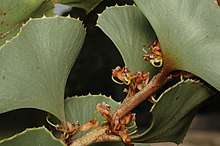Hakea brownii
Hakea brownii commonly known fan-leaf hakea[2] is a shrub in the family Proteaceae native to an area in the Wheatbelt region of Western Australia. This species shares a common name with Hakea baxteri due to its distinctive leaves.
| Hakea brownii | |
|---|---|
 | |
| Hakea brownii in the ANBG | |
| Scientific classification | |
| Kingdom: | Plantae |
| Clade: | Tracheophytes |
| Clade: | Angiosperms |
| Clade: | Eudicots |
| Order: | Proteales |
| Family: | Proteaceae |
| Genus: | Hakea |
| Species: | H. brownii |
| Binomial name | |
| Hakea brownii | |
 | |
| Occurrence data from Australasian Virtual Herbarium | |
Description
Hakea brownii is a lignotuberous shrub growing to 0.4 to 2.5 metres (1.3 to 8.2 ft) high. Smaller branches and new leaves are densely covered in matted rusty coloured silky hairs, becoming smooth by flowering. The leaves are ornamental, fan shaped, stiff, thickly textured and prickly toothed at the apex. They have straight sides tapering to the base, 2.8–6.5 cm (1–3 in) long and 2–6 mm (0.08–0.2 in) wide. The inflorescence consists of 6-10 small sweetly scented cream-brown flowers on an obscure stem. The pedicels are 2–6 mm (0.08–0.2 in) long thickly covered in matted silky rusty coloured hairs extending onto the lower part of the flower. The perianth is 5–7 mm (0.2–0.3 in) long and the style 7–9 mm (0.3–0.4 in) long. Flowers appear in clusters in the leaf axils or on old wood from August to November. The large rounded egg-shaped fruit are 3.5–5 cm (1–2 in) long and 4–4.5 cm (2–2 in) wide. The fruit surface is wrinkled and may have a network of veins tapering to a short beak.[2][3][4][5]
Taxonomy and naming
Hakea brownii was first described by Carl Meisner in 1845 and published in Plantae Preissianae.[6] The species was named after Robert Brown, librarian of the Linnean Society of London.[2][4]
Distribution and habitat
Hakea brownii is widespread from the coastal plains of the Murchison River through the central wheatbelt to Cape Riche. Grows on sandy loam, deep sand or sand over laterite in heath or shrubland. Requires a well-drained site with a sunny aspect. A frost-tolerant species, having uses in floral art and wildlife habitat.[2]
Conservation status
Hakea brownii is currently classified as "not threatened" by Western Australian Government.[4]
References
- "Hakea brownii". APNI. Retrieved 20 January 2019.
- Young, J A (2006). Hakeas of Western Australia:A Field and Identification Guide. J A Young. ISBN 0-9585778-2-X.
- Wilson (ed), Annette; Barker, Robyn M.; Haegi, Laurence A.; Barker, William R. (1999). "Flora of Australia" Vol.17B-Proteaceae 3 Hakea to Dryandra. Canberra/Melbourne: ABRS-Department of Environment and Heritage. ISBN 0-643-06454-0.CS1 maint: extra text: authors list (link)
- "Hakea brownii". FloraBase. Western Australian Government Department of Parks and Wildlife.
- "Hakea brownii". Flora of South Australia:Online. South Australian Government. Retrieved 14 February 2019.
- Meisner, Carl (1845). "Plantae Pressianae" (Volume 1). p. 569. Retrieved 15 February 2019.